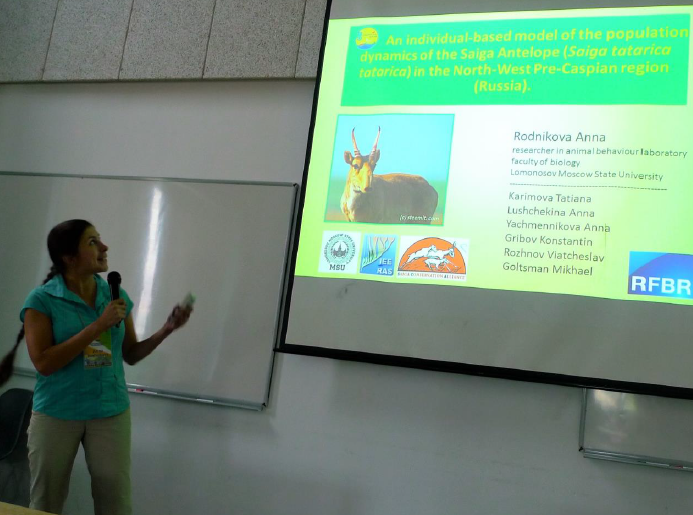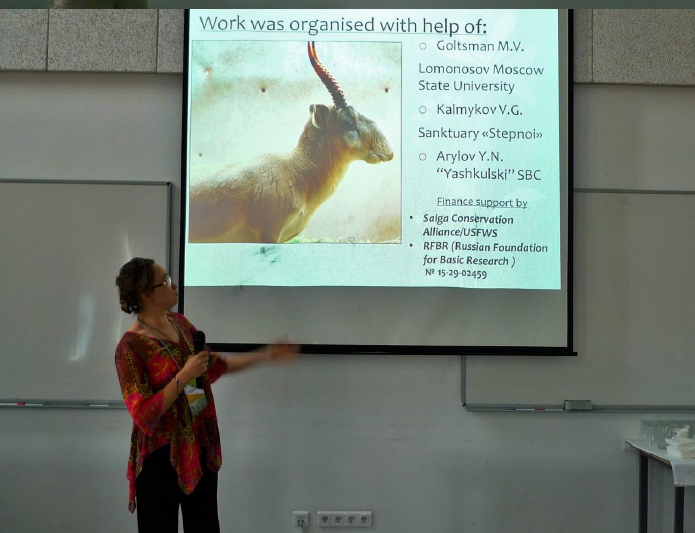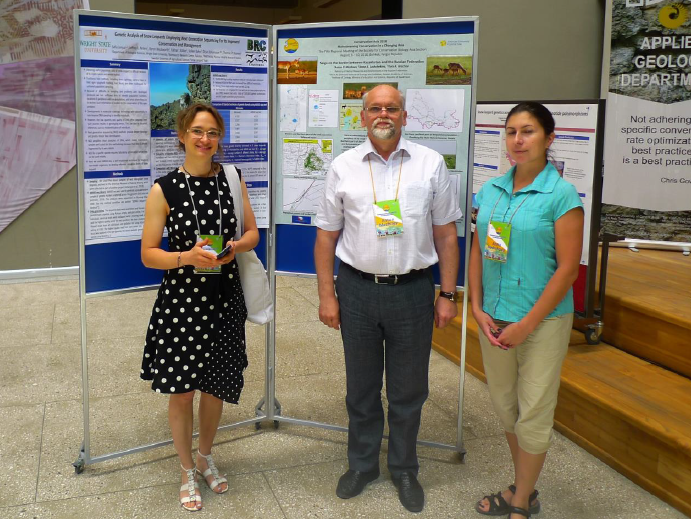Results of actual research presented at the conference are an excellent opportunity for detailed discussion, exchange of experience and attraction of attention to the objects were studied. In the beginning of August, three specialists from Russia (A.P. Mezhnev from MNREE RF, A.Y. Rodnikova from MV Lomonosov MSU and A.A. Yachmennikova from AN Severtsov IEE RAS) had their trip to Bishkek, Kyrgyz Republic, where from 6th to 10th of August the fifth international meeting “Updating the Conservation of Nature in a Changing Asia” took place. The meeting was held by the Society for Biodiversity Conservation (Sector Asia) with the sponsorship of a number of international foundations and organizations; the American University of Central Asia (AUCA) became the host organization of the Conference.
During the opening ceremony, the President of the American University, the chairman and organizers of the conference took their welcoming speech; and the concert of the Presidential Chamber Orchestra “Manas” filled the final chord of the ceremony with a harmonious.
The vast expanses of Asia are laying from the equatorial tropical jungle to the high Himalaya Mountains, from the taiga forests to the deserts of the Middle East; it has incredible biological diversity, pressed with a numerous anthropogenic influences. The Conference Meeting gave opportunity for many experts to discuss a wide range of issues; from biodiversity conservation through mathematics applied to special scientific researches in the field of genetics and technological innovations.
In total, the program of the meeting included also six plenary reports at which leading experts from different countries presented their vision of strategies for the conservation of endangered species on the territories which are under difficult social and economic conditions (Prof. Lu Zhi); the development of private organizations which play an important role for the effective protection of the nature of Asia, similar to such a system in Africa (Prof. Simon Hedges); explanation of modern statistical approaches in the environment monitoring for conservation (Prof. David Borchers); shared with a system of an automatic data processing system used to register animals at a gold mining territories in Kyrgyzstan (O. Medoeva); focused on the problems of the coexistence of humans and leopards in India (Vidya Athrea) and reported the actual work on the nature of the Kyrgyz Republic Conservation (Emil Shukurov).
Between the plenary reports there were thematic sessions with 10 minutes presentations were taken by other participants. The first working day at the session named “Recent Changes in the Population Ecology” Anna Y. Rodnikova (a junior researcher of the Biological Faculty of the MV Lomonosov Moscow State University from Russia, Moscow) presented an individual-based model of the population dynamics of the Saiga Antelope (Saiga tatarica tatarica) in the North-West Pre-Caspian region. The model was created and tested in collaboration with Karimova Tatiana, Lushchekina Anna, Yachmennikova Anna, Gribov Konstantin, Rozhnov Viatcheslav and Goltsman Mikhael. The model is based on the published data on the population dynamics before the saigas’ abundance decreased critically in 1998. The implemented scheme of the annual species cycle with the selected key stages and sex-age categories was shown, a diagram with logical blocks of the model work was also presented. Special attention was paid to the first results of model testing; these results showed an influence of adverse weather conditions and autumn official hunting to the population dynamics. The first questions on this report, which were discussed with the participants of the conference, concerned the technical side of the model work, the introduction of randomness, the reliability of the results obtained; but the practical application and the adapting of the model to the modern saigas population caused the most interest.

During the session «Technologies for conservation of biodiversity» took place on 9th of August Yachmennikova Anna A. (senior researcher of AN Severtsov Institute of ecology and evolution, Moscow, Russia) made her talk. Her presentation was focused on implementation of methodology of accounting saigas from the space by using satellite images with high resolution. This methodology was developed in 2014 by the team (Rozhnov VV, Dobrynin DV, Lushchekina AA, Karimova TY) from Severtsov Institute and Scanex Company. By using this it is possible to cover in the same time a huge territory of the natural steppe without any influence to animals there, without any disturbance of them. For implementation of methods there were used satellite images from Dec 2016 for the territory of Natural Sanctuary “Stepnoi”. With the help of rangers of this Sanctuary method and results were calibrated and verified, and confirmed during investigation. Session on new technologies attracted a lot of visitors of the Conference, there were no place for all of them in the room, people seated on the floor and stayed along the wall of the auditory. Questions and discussion of the talk were mainly focused on the development of this method in the direction of automatical programmed work for an animals’ accounting; also integration of methods were discussed – how tagging with the satellite transmitters could help and how to write mathematical algorithm for the GIS based on satellite animals’ detection could be used. As it became obvious such method of animals accounting is interesting and actual also for ungulates of open spaces in India, Mongolia, Kazakhstan, Uzbekistan, Kirgyzstan and others.
Also at the poster session, Anton P. Mezhnev presented his report. The theme of the poster presentation was “Saigas on the border between the Kazakhstan and Russia ” (work is coauthored with AA Lushchekina and YA Grachev). In recent years, saiga surveillance in border areas in the Volga-Urals and Betpakdala saiga populations has increased. The general information for the southeast of the Orenburg region (Betpakdala population) shows for now continued increasing of the occurrence rate of saigas despite the catastrophic epizootic in Kazakhstan (2015). This confirms the existence of the relatively isolated saigas’ peripheral groups. Another question discussed in the presentation was focused on the problem of unhindered migration of saigas across the border where barriers could be organized to prevent the spread of epizootics (a precedent was noted in the Volgograd region in 2018).

During the Conference a special attention of Russian team was oriented to the session on “Central Asian Ungulates and Health”. Reports were presented there discussed epidemics of epizootics in saiga’s and gazella’s populations in Kazakhstan and Mongolia, the spread of foot and mouth disease in gazelle in Mongolia and the problem of transferring diseases from livestock to the wild ungulate populations in Afghanistan.
As the impression from the meeting – it was held at a decent high level, with a lot of benefits of sharing experiences, important information and fruitful communication which could not be overemphasized.
Specialists from Russia participation in the meeting became possible thanks to the support provided by the Saiga Conservation Alliance. The authors feel sincere gratitude to the Alliance and look forward to further cooperation!

